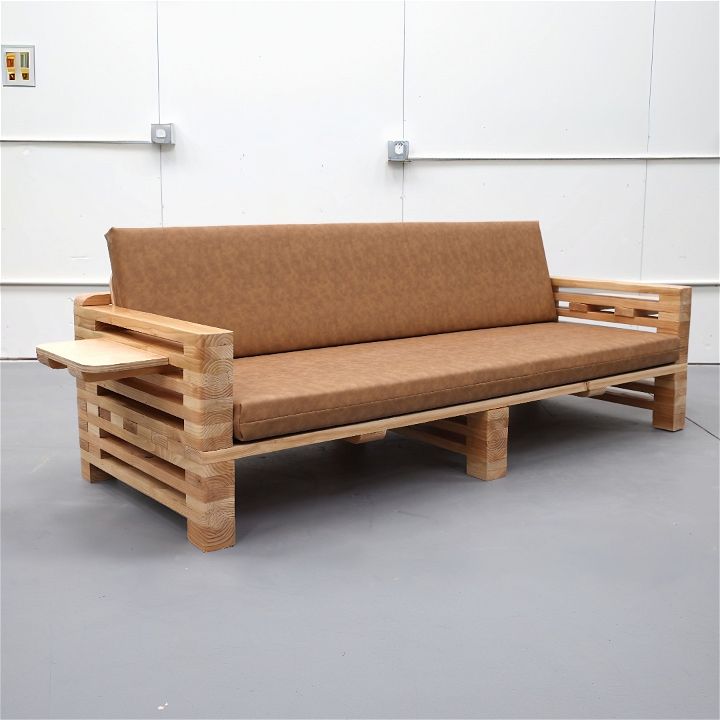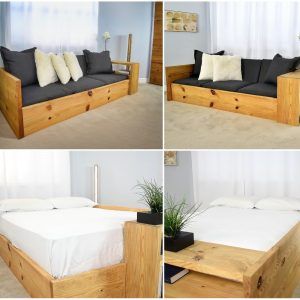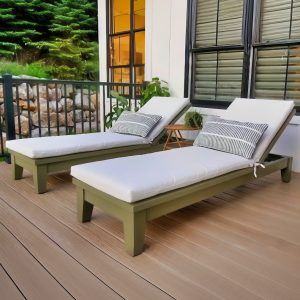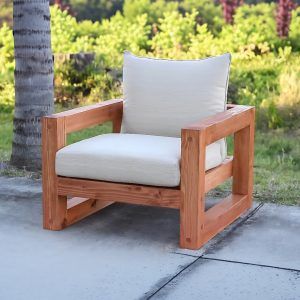Building your own furniture is a cheap way to add personalized and functional pieces to your home without breaking the bank. One project that embodies affordability, simplicity, and style is constructing a 2×4 DIY sofa. or couch With lumber prices returning to more reasonable rates, now’s the perfect time to tackle this project. This guide walks you through building a DIY 2×4 sofa for around $160, based on a hands-on experience shared through a detailed YouTube tutorial.

Why Build Your Own 2×4 Sofa?
Not only does building your own sofa offer the satisfaction of building something unique for your home, but it also allows for customization in size, finish, and comfort that suits your space perfectly. For those new to woodworking or those with more experience, this project is adaptable, reinforcing skills and offering challenges to overcome, such as working with imperfect lumber and mastering glue-ups.
Skill Assessment & Project Alternatives
Before diving into building your own sofa, it’s important to evaluate your skill level and consider various project options that align with your abilities. Here’s a straightforward guide to help you get started:
Self-Evaluation
Are you a beginner, intermediate, or advanced DIYer? Take a moment to reflect on your experience with tools, woodworking, and upholstery. If you’re unsure, here’s a quick checklist:
- Have you handled basic tools like hammers and screwdrivers?
- Do you have experience with power tools?
- Have you completed any woodworking projects before?
- Are you familiar with sewing or upholstery?
If most of your answers are ‘yes’, you might be ready for more complex projects. Otherwise, start with simpler designs.
Skill-Based Variations
Choose a sofa design that matches your skill level:
- Beginner: Consider a pallet sofa. It’s simple; just stack pallets and add cushions.
- Intermediate: Try building a basic 2×4 wooden frame and use pre-made cushions.
- Advanced: Challenge yourself with intricate joinery and custom upholstery.
“No-Build” Options
Not ready to build from scratch? No problem! You can:
- Find a second-hand sofa and personalize it with new slipcovers.
- Change the sofa legs for a fresh look.
- Add decorative pillows or throws to make an old sofa feel new.
If you have basic skills, it’s time to move on to the next steps in building your own sofa. Let’s get started.
Planning & Design Focus
Making your own DIY sofa is not only a way to get exactly what you want in terms of size, style, and comfort, but it’s also a fantastic project that can bring a sense of accomplishment. The key to success lies in careful planning and design. Here’s how you can start.
Space Measurement & Needs
Before anything else, understanding the space where your new sofa will live is crucial. Grab a tape measure and note down the dimensions of the area. Remember, you’re not just measuring to ensure the sofa fits, but also to make sure there’s enough room to move around it comfortably.
Consider the sofa’s functionality:
- Seating Capacity: How many people do you want to accommodate? This will influence the length of the sofa.
- Storage Needs: Do you need built-in storage for things like blankets or board games? This could determine the design of the base.
- Style: What style will complement your room? Modern, traditional, or perhaps something minimalist? The design should flow with the rest of your space.
Sketching & Resource Lists
Now, take your ideas and sketch them out. This doesn’t have to be a masterpiece but sketching your vision will help clarify what you want and serve as a guide during construction.
Then, make a list of materials and tools you’ll need. Common items include wood for the frame, foam for cushioning, fabric for upholstery, screws, and tools like a saw, hammer, and staple gun. Don’t forget to list potential suppliers.
For those looking to compare costs, websites like Home Depot, Lowe’s, or local hardware stores often provide prices online. Fabric stores like Joann Fabrics or online marketplaces like Etsy can give you an idea of upholstery costs.
“Upcycling” Angle
For a budget-friendly or eco-conscious approach, consider upcycling. Old pallets, for example, can be repurposed into a unique sofa frame. Reclaimed wood not only has character but is also a sustainable choice.
Here are a few tips for upcycling:
- Inspect: Make sure the wood is in good condition, without major cracks or rot.
- Clean: Thoroughly clean your materials. A good scrub can bring old wood back to life.
- Safety: When using pallets, ensure they’re safe for indoor use. Look for the HT stamp, which means they were heat-treated, not chemically treated.
Remember, upcycling might require additional prep work, but the result can be a one-of-a-kind piece that’s both eco-friendly and cost-effective.
By measuring your space, planning your design, and choosing materials wisely, you can make a custom DIY sofa that looks great and fits your needs.
Materials Needed
- 2×4 lumber (amount will vary based on sofa size; consult detailed plans)
- Wood glue
- Sandpaper (various grits)
- Finish of choice (e.g., varnish or protective sealant for outdoor use)
- Cushions for seating and back support
- Tools: Miter saw, clamps, orbital sander, belt sander (optional), hammer or rubber mallet
Steps to Building Your DIY Sofa
Learn the essential steps to building your own sofa from scratch with our comprehensive guide.
Plan and Cut Your Lumber
Start by cutting your 2×4 lumber according to the cut list provided in the project plans. Precise cuts are crucial for easy assembly later.
Prep and Sand Your Pieces
Before assembly, sand all pieces up to 120 grit to ensure a smooth finish and ease the later finishing process.
Assemble End Sections
The end sections serve as both the armrests and legs. Arrange and glue your cut pieces in the pattern outlined in the plans. Clamping smaller sections first makes the process more manageable.
Install Backbone and Seating Area
Piece together the back and seating area, ensuring the structure is square and at the correct width. Add spacer blocks as needed to maintain structure integrity.
Add the Cushions
Measure and adjust the frame if necessary to fit your cushions perfectly. This step can personalize the sofa to the exact dimensions and look you desire.
Final Assembly and Sanding
Assemble the larger components and perform a final sanding. Pay attention to easing edges and smoothing out any imperfections.
Apply Finish
Choose a finish that complements your space and offers the protection needed for how you’ll use the sofa. Apply according to the product instructions for best results.
Enjoy Your New Sofa
With the construction complete, place your cushions, and enjoy the comfort and satisfaction of your DIY efforts.
Expanding Your Project
Consider building matching or complementary furniture pieces, such as a coffee table or side tables, using similar techniques and materials. This approach can unify your space and further tailor it to your needs and aesthetics.
Common Pitfalls and Troubleshooting
- Lumber Quality: Select the straightest pieces of lumber possible to ease construction. However, minor warps can often be corrected during the glue-up stages or counteracted by strategic placement.
- Glue-Up: Rushing through the glue-up process can lead to misalignments. Take your time, and don’t hesitate to do dry runs before applying glue.
Why Behind Steps?
Understanding the reasons behind specific steps can heighten your craftsmanship. For instance, pre-sanding pieces before assembly simplifies achieving a uniform finish, and spacing pieces during assembly ensures proper structural support and symmetry.
Video Tutorial
Want a visual demonstration? Watch a step-by-step video tutorial on YouTube here. It provides a clear and easy-to-understand visual walkthrough of the techniques, making it a great companion to this written guide.
Based on the detailed guide for building a DIY 2×4 sofa for $160 from YouTube, let’s create a comprehensive FAQ section to accompany it. This FAQ will prioritize clarity, helpfulness, and address genuine reader concerns while ensuring it remains unique and insightful.
DIY Sofa FAQs
Discover answers to all your DIY sofa questions in one comprehensive guide. Learn tips, tricks, and expert advice for your project.
Can I build this sofa without a planer?
Yes, planing down the 2x4s to remove the rounded edges is optional. If you don’t have access to a planer, you can skip this step. The project is designed to be accessible, even without planing the wood.
Do I need a miter saw for this project?
While a miter saw is recommended for its precision and efficiency in making a large number of cuts, you can use a circular saw if you’re careful and measure your cuts accurately. The miter saw just makes the process quicker and more precise.
How do I ensure the armrests and legs are glued evenly despite the wood not being perfectly straight?
Ensuring your work surface is flat is crucial for keeping the glue-ups even. Take your time during this step to align everything as best as possible. Using clamps and checking the alignment frequently can help compensate for any warping in the 2x4s.
Can I adjust the size of the sofa to fit different cushion sizes?
Yes, the sofa design is versatile. If you have cushions of a different size, you can adjust the length of the 2x4s accordingly. It’s a smart move to measure your cushions first and then adjust the sofa dimensions to ensure a perfect fit.
What kind of finish can I use if I want to place the sofa outdoors?
For outdoor use, consider using a spar varnish like TotalBoat Gleam Spar Varnish for its enhanced protection against the elements. This will help preserve the wood and maintain the appearance of your sofa over time.
Is it necessary to add braces or l-brackets to the sofa for stability?
The design is intended to be sturdy without the need for additional bracing. However, depending on your use and if you find the need for extra stability, adding l-brackets is an option. Keep an eye on the sofa’s performance and add brackets if necessary.
Can I add any customization to the sofa, like floating end tables?
Absolutely! The guide mentions adding removable floating end tables as a creative customization. You can use scrap pieces and plywood to create these additions, enhancing the functionality and aesthetics of your sofa. Feel free to explore other custom features that meet your needs and preferences.
These FAQs aim to provide help while promoting customization based on personal needs and resources.
Conclusion
By tackling this DIY sofa project, not only do you end up with a price-conscious, stylish couch for your home, but you also gain the invaluable experience and satisfaction that comes with DIY woodworking. Whether you choose to keep the sofa indoors or adapt it for outdoor use, it’s sure to be a conversation starter and a personal point of pride.
Save this to Pinterest to share with others or for later use.





